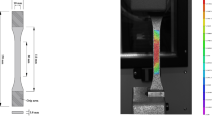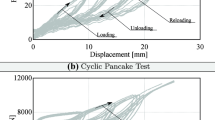Abstract
In the context of lightweight design and modern hybrid technologies, the importance of structural and soft adhesives in industrial applications is increasing. Therefore, this paper examines a relatively soft polyurethane adhesive characterized by showing nonlinear viscoelastic behavior at room temperature and enduring large deformations. It is well suited for applications under dynamic loadings and can compensate gap changes generated by materials with different thermal expansion coefficients. Theoretically, the examined one-component polyurethane adhesive can be cured either thermally or through humidity, resulting in the same mechanical characteristics. Comparing both curing reactions, humidity curing is much slower than thermal curing. The latter can be controlled through the temperature, which may be applied through heating rates of up to \(150\,\hbox {K}\,\hbox {min}^{-1}\). However, in comparison with metals polyurethane conducts the heat with a much smaller rate which results in high temperature gradients within the adhesive layer. This paper focuses on the modeling of a fast-curing polyurethane adhesive under consideration of the changes in density and thermomechanical material properties induced by thermal curing. Therefore, the material properties need to be observed throughout the thermal curing process, from the uncured fluid to the cured rubber material. In the long term, the accurate prediction of the materials behavior will ultimately facilitate the optimization of the curing process.
Similar content being viewed by others
References
Adolf, D.B., Chambers, R.S.: A thermodynamically consistent, nonlinear viscoelastic approach for modeling thermosets during cure. J. Rheol. 51(1), 23–50 (2007)
Deutsches Institut für Normung e.V.: DIN 51007 Thermische Analyse (TA), Differenzthermoanalyse (DTA) (1994)
Enns, J.B., Gillham, J.K.: Time-temperature-transformation (TTT) cure diagram: modeling the cure behavior of thermosets. J. Appl. Polym. Sci. 28(8), 2567–2591 (1983)
Fournier, J., Williams, G., Duch, C., Aldridge, G.A.: Changes in molecular dynamics during bulk polymerization of an epoxide-amine system as studied by dielectric relaxation spectroscopy. Macromolecules 29(22), 7097–7107 (1996)
Grambow, A.: Bestimmung der Materialparameter gefüllter Elastomere in Abhängigkeit von Zeit, Temperatur und Beanspruchungszustand. Ph.D. thesis. RWTH Aachen (2002)
Hossain, M., Possart, G., Steinmann, P.: A finite strain framework for the simulation of polymer curing. Part I: elasticity. Comput. Mech. 44(5), 621–630 (2009a)
Hossain, M., Possart, G., Steinmann, P.: A small-strain model to simulate the curing of thermosets. Comput. Mech. 43(6), 769–779 (2009b)
Leistner, C., Hartmann, S., Abliz, D., Ziegmann, G.: Modeling and simulation of the curing process of epoxy resins using finite elements. Continuum Mech. Thermodyn. 1–24 (2018). https://doi.org/10.1007/s00161-018-0708-9
Leistner, C., Hartmann, S., Wittrock, J., Bode, K.: Shrinkage behavior of araldite epoxy resin using archimedes’ principle. Polym. Test. 67, 409–416 (2018b)
Liebl, C.: Viskoelastisch-viskoplastische Modellierung von Strukturklebstoffen während der Aushärtung. Ph.D. thesis. Bundeswehr University Munich (2014)
Lion, A.: Einführung in die lineare viskoelastizität. In: Beiträge zur Materialtheorie. A. Lion (2007)
Lion, A., Höfer, P.: On the phenomenological representation of curing phenomena in continuum mechanics. Arch. Mech. 59(1), 59–89 (2006)
Mahnken, R.: Thermodynamic consistent modeling of polymer curing coupled to visco-elasticity at large strains. Int. J. Solids Struct. 50(13), 2003–2021 (2013)
Pahl, M., Gleißle, W., Laun, H.M.: Praktische Rheologie der Kunststoffe und Elastomere. VDI-Gesellschaft Kunststofftechnik (1991)
Rabearison, N., Jochum, C., Grandidier, J.C.: A cure kinetics, diffusion controlled and temperature dependent, identification of the araldite ly556 epoxy. J. Mater. Sci. 46(3), 787–796 (2011)
Shutov, A.V., Landgraf, R., Ihlemann, J.: An explicit solution for implicit time stepping in finite strain viscoelasticity. Comput. Methods Appl. Mech. Eng. 265, 213–225 (2013)
Sourour, S., Kamal, M.R.: Differential scanning calorimetry of epoxy cure: isothermal cure kinetics. Thermochimica Acta 14, 41–59 (1976)
Williams, M.L., Landel, R.F., Ferry, J.D.: The temperature dependence of relaxation mechanisms in amorphous polymers and other glass-forming liquids. J. Am. Chem. Soc. 77, 3701–3707 (1955)
Yagimli, B.: Kontinuumsmechanische Betrachtung von Aushärtevorgängen. Ph.D. thesis. Bundeswehr University Munich (2013)
Yagimli, B., Lion, A.: Experimental investigations and material modelling of curing processes under small deformations. J. Appl. Math. Mech. 91(5), 342–359 (2011)
Yeoh, O.H., Fleming, P.D.: A new attempt to reconcile the statistical and phenomenological theories of rubber elasticity. J. Polym. Sci. 35(12), 1919–1931 (1997)
Acknowledgements
We would like to thank the Deutsche Forschungsgemeinschaft (DFG) (Grant No. LI696/17-1) for funding the research project from which this paper resulted.
Author information
Authors and Affiliations
Corresponding author
Additional information
Communicated by Michael Johlitz, Lucien Laiarinandrasana, Yann Marco.
Publisher's Note
Springer Nature remains neutral with regard to jurisdictional claims in published maps and institutional affiliations.
Rights and permissions
About this article
Cite this article
Jennrich, R., Lion, A., Johlitz, M. et al. Thermomechanical characterization and modeling of fast-curing polyurethane adhesives. Continuum Mech. Thermodyn. 32, 421–432 (2020). https://doi.org/10.1007/s00161-019-00788-w
Received:
Accepted:
Published:
Issue Date:
DOI: https://doi.org/10.1007/s00161-019-00788-w




